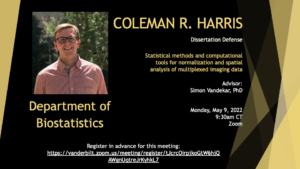Coleman Harris dissertation defense – May 9
PhD candidate Coleman Harris will be defending his dissertation on Monday, May 9, at 9:30 a.m. Central Time. All are invited. To attend the defense, which will take place online, please register in advance.

Statistical methods and computational tools for normalization and spatial analysis of multiplexed imaging data
Multiplexed imaging is a nascent single-cell assay that can be used to understand and analyze complex processes in tissue-based cancers, autoimmune disorders, and more. These methods are valuable in understanding cell–cell interactions, but few standardized processing steps or analysis methods of multiplexed imaging data are available.
First, we implement and compare data transformations and normalization algorithms in multiplexed imaging data. Our methods adapt the ComBatalgorithm and functional data registration methods to remove slide effects in this domain, and we present an evaluation framework to compare the proposed approaches. We present clear slide-to-slide variation in the raw, unadjusted data and show that normalizing multiplexed imaging data by its slide mean reduces this variation while preserving and improving the biological signal.
Second, we develop the R package, mxnorm, to implement, evaluate, and visualize normalization techniques for multiplexed imaging data. This software allows users to extend normalization methods in multiplexed imaging, andprovides a robust evaluation framework to measure both technical variability and the efficacy of various normalization methods. Further, the package provides users with the ability to supply user-defined normalization methods and thresholding algorithms to assess normalization in this data.
Third, we introduce spatial statistics methods to understand the relationships of different biological markers following the removal of technical variation in multiplexed imaging data. Here we leverage marked point process methods to derive and compare three spatial statistics methods: Keren’s permutation test for spatial proximity, Lee’s L test for bivariate spatial data, and a proposed cumulative mark cross-correlation (CMCC) statistic. We then provide an evaluation of the adapted methods, including a correlation analysis and cross-validated prediction modeling analysis, to identify optimal spatial statistics methods in multiplexed imaging data.